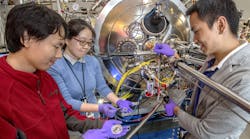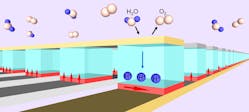A team of researchers from the Massachusetts Institute of Technology (MIT) and the U.S. Department of Energy’s (DoE) Brookhaven National Laboratory has discovered how to use hydrogen ions, “pumped” from water in the air at room temperature, to electrically control magnetism within a thin sample of a magnetic material. This approach for manipulating magnetic properties could speed up advances in computing, sensors, and other technologies.
The researchers used hydrogen ions for reversible magneto-ionic switching in a layered structure consisting of a platinum base, cobalt, palladium, gadolinium oxide, and a gold contact to top it off. Palladium (Pd) can store hydrogen within the “nooks” of its atomic lattice. Placing a voltage across the sample and switching it between positive and negative, pumped hydrogen in and out of the Pd layer, switching the magnetism back and forth from out-of-plane to in-plane. This is the first time that scientists have demonstrated reversible “hydriding” of a heavy metal.
To verify that the hydrogen was inserted into the Pd layer, the group put through x-ray absorption spectroscopy (XAS) at the CSX beamline. CSX lets researchers use soft x-ray scattering and imaging tools to study the electronic texture and behaviors of composite materials. With XAS, researchers determine the local electronic structure around specific elements in samples. In this project, it determined that inserting hydrogen into the Palladium changed its magnetic properties.
This illustration shows of the layered sample shows water molecules in the air used as a source of hydrogen ions. When a positive voltage is applied across the sample, the ions move to the bottom layer, causing a switch in the direction of the magnetic fields (red arrows). The oxygen atoms eventually return to the air.
The most likely use this research is in developing a new platform for spintronics—devices based not just on electronic charge, but also electronic spin (the built-in property of an electron that makes it act as a tiny magnet).
Unlike standard electronics, which rely on complementary metal-oxide semiconductor (CMOS) technology used to make each of the billions of transistors in microchips, spintronic devices are built out of magnetic materials, which contain magnetic atoms such as iron or manganese. Spintronics devices can retain their magnetic properties without a constant supply of power, unlike standard microchips. Also, because they generate significantly less heat, they are more energy efficient.
“As CMOS technologies approach the end of their roadmap, spin-based devices are being widely pursued for the beyond-CMOS era,” said the study’s lead researcher, MIT’s Geoffrey Beach, a professor of materials science and engineering and co-director of the MIT Materials Research Laboratory. “One of the requirements for bringing spintronics into the mainstream is an effective way to electronically control magnetism. Essentially, we are trying to make the magnetiuc analog of a transistor.”
One approach to achieving this control is by inserting ions into the structure that can move between the layers and modulate its electromagnetic behavior. This is called magneto-ionic switching. Researchers have already yielded some promising results, but the types of ions used in previous investigations caused more problems than they solved. In this study, the team was able to remedy some of these issues by using hydrogen ions (H+). Hydrogen ions are relatively innocuous and the smallest possible ions, so they are ideal for inducing rapid electric-field-driven changes in solid-state structures.
“Magneto-ionic switching is an important pathway toward electrically manipulating magnetism at low power,” said lead Brookhaven researcher Wen Hu, a beamline scientist at the CSX beamline. “Hydrogen-ion migration, controlled by electrical voltages, plays a key role in this research and could potentially lead to new spintronic device applications.”


